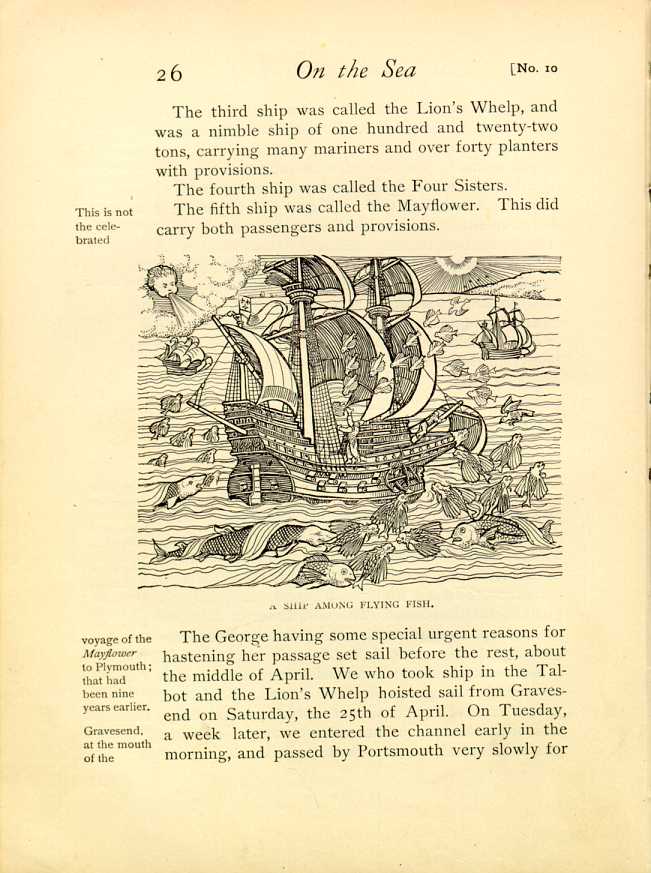| Colonial Children | ||
10. Far, Far at Sea
BY THE REV. FRANCIS HIGGINSON (1629)[53]
THE names of the five ships were as follows: —
The first was called the Talbot, a good and strong ship of three hundred tons and nineteen pieces of ordnance, with a crew of thirty mariners. This ship carried more than a hundred planters,[54] six goats, five great pieces of ordnance, with all manner of ammunition and provisions for the Plantation for a twelfth-month.[55]
The second ship was called the George. This also was a strong ship of about three hundred tons, with a crew of thirty mariners. Her general cargo was of cattle, twelve mares, thirty cows, and some goats. She had fifty-two planters on board.
The third ship was called the Lion's Whelp, and was a nimble ship of one ' hundred and twenty-two tons, carrying many mariners and over forty planters with provisions.
The fourth ship was called the Four Sisters.
The fifth ship was called the
Mayflower.[56] This did carry both passengers
and provisions.

A SHIP AMONG FLYING FISH.
[Description: Black and white illustration of a ship at sea with fish
"flying" as high as the sails.]
The George having some special urgent reasons for hastening her passage set sail before the rest, about the middle of April. We who took ship in the Talbot and the Lion's Whelp hoisted sail from Gravesend on Saturday, the 25th of April.[57] On Tuesday, a week later, we entered the channel early in the morning, and passed by Portsmouth very slowly for
Wednesday, early in the morning a shallop was sent from the ship to fetch us to Yarmouth,[60] but the weather proved rough and our women desired to be set on shore at a point three miles short of Yarmouth, and the rest of the way we went on foot, and then regained the ship. The next Sabbath being the first Lord's Day on which we had been at sea we were disturbed in our morning services by the charge of a man-of-war.[61] The captain of this ship finding us too strong for him durst not venture to assail us, but made off.
This day, my two children, Samuel and Mary, began to be sick of the small pox, which was brought into the ship by one Mr. Brown who was sick with the small pox at Gravesend.[62] By Tuesday, towards night, my daughter grew sicker. She died by five o'clock that night, and was the first of our ship to be buried in the great Atlantic Sea. By the following Saturday we were comforted with the hope that my son Samuel would get well. One morning while we were at prayers, a strong sudden blast of wind came from the south, stirred up the waves and tossed us more than ever before. Towards night the wind abated by little and little until it was calm. Mr. Goffe's great dog, that fell overboard during the gale, could not be recovered.
On Wednesday, just two months[63] after we left our English port, we had a clear sight of America, and of Cape Sable which was seven or eight leagues to the south.[64] On the sea about us we saw yellow gilly-flowers.[65] About the afternoon of the next day we had a clear sight of many islands and hills by the seashore. We saw an abundance of mackerel, and a great store of whales puffing up water as they went by our ship. Their enormous size astonished those of us who had not seen them before; their backs appeared like small islands.
Friday, after the fog cleared, we saw many schools of mackerel on every side of our ship. . The sea was abundantly stored with rock-weed and yellow flowers. By noon we were within three leagues of Cape Ann; and as we sailed along the coast we saw every hill and dale and every island full of great woods and high trees. The nearer we came to the shore the more flowers we saw, sometimes scattered abroad, sometimes joined in sheets nine or ten yards long. Towards night, we came near the harbor of Salem, whither we were bound.
Higginson called this narrative "The true story of the voyage to New England, made during the last summer. Begun on the 25th April, 1629."
This is not the celebrated voyage of the Mayflower to Plymouth; that had been nine years earlier.
| Colonial Children | ||